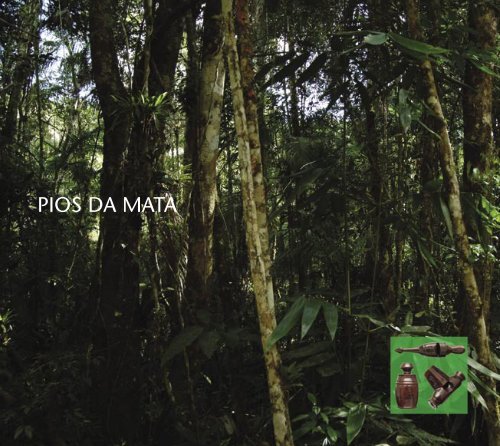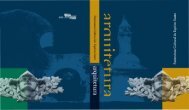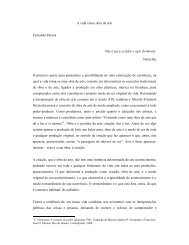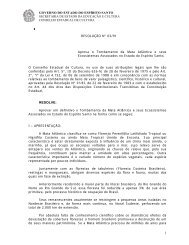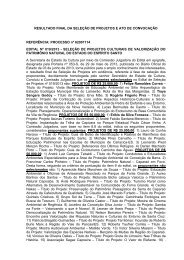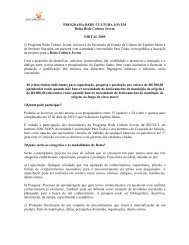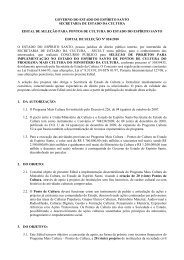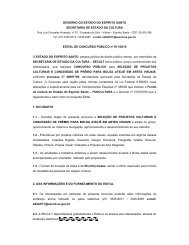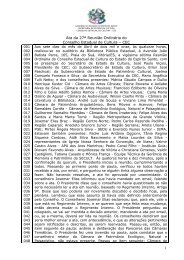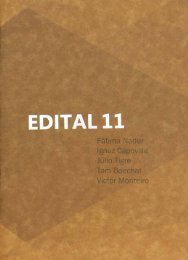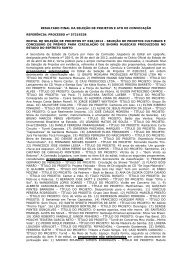You also want an ePaper? Increase the reach of your titles
YUMPU automatically turns print PDFs into web optimized ePapers that Google loves.
PIOS DA MATA Patrimônio do Espírito Santo<br />
WOODLAND BIRDCALL WHISTLES A Heritage of the State of Espirito Santo<br />
Exposição no Museu da Casa Brasileira<br />
São Paulo, dezembro de 2004<br />
Exibition at Museu da Casa Brasileira<br />
São Paulo, december, 2004<br />
Patrocínio Sponsors<br />
Secretaria de Estado da Cultura do Espírito Santo e<br />
Serviço de Apoio às Micro e Pequenas Empresas do Espírito Santo<br />
State Secretary of Culture of Espírito Santo and SEBRAE Espírito Santo
Para nós do Estado do Espírito Santo é motivo de muito orgulho<br />
exibir esta mostra, no Museu da Casa Brasileira em São Paulo,<br />
por duas razões.<br />
A primeira deve-se ao fato de ser um projeto institucional. Tal iniciativa<br />
testemunha o compromisso da Secretaria de Estado da Cultura e<br />
do SEBRAE-ES com a política de preservação e revitalização dos<br />
nossos bens e valores culturais. A identidade cultural de um Estado<br />
se constrói a partir de sua história e da herança arquitetônica e<br />
simbólica legada por seus antepassados. Por isso, tão importante<br />
quanto restaurar e revitalizar as edificações que contam a nossa<br />
história, é conservar nossos bens culturais imateriais, incentivando<br />
o seu estudo e a sua prática.<br />
O Estado do Espírito Santo tem uma riqueza étnica ímpar, decorrente<br />
dos inúmeros imigrantes que <strong>aqui</strong> aportaram e mesclaram suas<br />
culturas de origem com os índios, negros africanos, italianos, alemães,<br />
pomeranos, sírios-libaneses, suíços, belgas, luxemburgueses,<br />
austríacos, holandeses, resultando numa pluralidade de ritmos,<br />
timbres, danças e elementos visuais expressos em seus folguedos<br />
originários, e releituras feitas por outras manifestações artísticas.<br />
Há um sentido místico religioso, de louvor, de sentimento coletivo<br />
na música, na coreografia e nas letras dos cantos. São enfim as<br />
folias de reis, os rei de boi, o tambor de São Benedito, as bandas<br />
de congo, o Ticumbi, o sabor da moqueca capixaba, privilegiado<br />
pelo mar, pelas montanhas, dunas e pelos manques. Celebrar esta<br />
diversidade e revelar a todos a beleza de nossa cultura tradicional<br />
e étnica é dever da Secretaria de Estado da Cultura.<br />
It is with great pride that we, the people of the state of Espírito<br />
Santo, present this exhibition at the Museu da Casa Brasileira in<br />
São Paulo, for two reasons:<br />
The first is due to the fact that this is an institutional project. Such<br />
an initiative confirms the commitment of the State Secretary of<br />
Culture and SEBRAE in Espírito Santo in their preservation and<br />
revitalization policy for our cultural property and values. The cultural<br />
identity of Espírito Santo has been constructed through its history<br />
and the architectural and symbolic heritage left by its forefathers.<br />
For this reason, as important as restoring and revitalizing buildings<br />
that tell our history is preserving our intangible cultural heritage,<br />
encouraging both research and practice.<br />
The state of Espírito Santo has unmatched ethnic wealth, resulting<br />
from innumerous immigrants that set up shop combining their<br />
original cultures with those of the Indigenous peoples, Africans,<br />
Italians, Germans, Poles, Belgians, people from Luxembourg,<br />
Austria, Holland, Switzerland, as well as Lebanese people,<br />
resulting in a mix of rhythms, tunes, dances and visual elements<br />
expressed in their original endeavors, and reinterpretations made<br />
by other forms of artistic manifestations. There are religious<br />
mystical meanings, of praise, of collective significance in the<br />
music, in the choreography and in the lyrics of the songs. They<br />
are, in reality, folias de reis, the reis de boi, the tambor of Saint<br />
Benedict, the conga bands, the Ticumbi dance, the flavor of the<br />
moqueca made in Espírito Santo, aided by the closeness of the<br />
sea, the mountains, the dunes and the mangrove. Celebrating this
A segunda razão deve-se ao fato de que o projeto ocorre justamente<br />
no momento em que a Fábrica de Pios fundada por Maurílio Coelho,<br />
em Cachoeiro de Itapemirim celebra 101 anos de existência.<br />
O tema da mostra Pios da Mata - Patrimônio do Espírito Santo é parte<br />
do compromisso de valorização do patrimônio cultural do povo<br />
do Espírito Santo em sintonia com as ações e programas desenvolvidos<br />
pela Secretaria de Estado da Cultura na perspectiva de<br />
elaborar ações <strong>para</strong> conhecer, reconhecer, preservar, promover e<br />
revitalizar o patrimônio cultural do Estado, alem de promover e<br />
difundir a cultura capixaba em outros Estados brasileiros.<br />
A exposição no Museu da Casa Brasileira, em São Paulo, também amplia<br />
a implementação do programa Cidadania Cultural. Os bornais<br />
em tecido, contendo 3 pios, produzidos pelos jovens artesãos, vêm<br />
acompanhados de um CD que ensina como utilizar os pios. É o<br />
exercício da cidadania a partir da prática artística, uma importante<br />
ferramenta <strong>para</strong> recolocar o homem em contato com a natureza. A<br />
gravação do DVD Pios da Mata, relata a história da manufatura dos<br />
pios e o habitat dos pássaros na Mata Atlântica do Espírito Santo.<br />
É através do registro e difusão dos nossos valores culturais, que se reconhece<br />
um saber, sua prática, usos e costumes buscando formas<br />
de reinserção desta prática na comunidade, tocando com os nossos<br />
sons melodiosos a sensibilidade de todo o país.<br />
E como diz o nosso governador Paulo Hartung: “Somos capixabas. E<br />
temos planos <strong>para</strong> sermos mais”.<br />
Neusa Mendes<br />
Secretaria de Estado da Cultura do Espírito Santo<br />
diversity and revealing to all the beauty of our traditional culture<br />
and ethnicity is the duty of the State Secretary of Culture.<br />
The second reason is that the project is being held at the precise<br />
moment in which the Maurílio Coelho Birdcall Whistle Factory, in<br />
Cacheiro do Itapemirim, celebrates its 101th anniversary.<br />
The theme of the exhibition Woodland Whistles – Espírito Santo<br />
Heritage is part of the Espírito Santo people’s commitment and<br />
appreciation of the cultural heritage in sync with the actions and<br />
programs developed by the State Secretary of Culture aiming at<br />
elaborating actions to learn, recognize, preserve, promote and<br />
revitalize the State’s cultural heritage, besides promoting and<br />
publicizing the Espírito Santo culture in other Brazilian States.<br />
The exhibition being held at the Museu da Casa Brasileira, in<br />
São Paulo, also expands the implementation of the Cultural<br />
Citizenship program. The cloth bags contain 3 whistles, produced<br />
by young craftsmen, and a CD that teaches how to use them.<br />
It is an effort of citizenship awareness encouraged through the<br />
practice of art, an important tool for putting people back in touch<br />
with nature. The recording of the DVD Pios da Mata (Woodland<br />
Whistles) conveys the story of the production of the whistles and<br />
the habitat of the birds in the Espírito Santo woodlands.<br />
It is through the documentation and publicizing of our cultural<br />
values that a specific knowledge and its practices, uses and customs<br />
are recognized and thus reintroduced to the community, touching<br />
the sensitivity of the entire country with our melodious notes. In<br />
the words of our governor Paulo Hartung: “We are capixabas from<br />
Espírito Santo. And we have plans to be much more.”<br />
Neusa Mendes<br />
Espírito Santo State Secretary of Culture
Paciência, precisão e dedicação. A vida do capixaba Maurílio Coelho<br />
se mistura à história da Fábrica de Pios de Aves fundada há 101<br />
anos, em Cachoeiro de Itapemirim, no Espírito Santo. Uma trajetória<br />
que começou com o aprendizado junto aos índios “Puris”.<br />
Suas mãos hábeis e seu interesse pela natureza transformaram com<br />
exatidão a madeira <strong>para</strong> dela extrair o perfeito som.<br />
O ofício de fabricar os pios continua com o mesmo esmero do início<br />
do século, e ainda hoje é arte à prova de testes: a madeira bruta<br />
é pre<strong>para</strong>da <strong>para</strong> ser acoplada ao torno e, com rústicas ferramentas,<br />
inicia-se o desbaste e a medição da madeira. As partes são<br />
encaixadas e coladas e as peças ganham os ajustes finais, sendo<br />
envernizadas em câmaras especiais.<br />
A Fabrica de Pios de Aves é um modelo de emprendedorismo a ser<br />
explicado. Serve de exemplo e inspiração <strong>para</strong> quem pensa em<br />
lançar-se no mundo dos negócios. Perseverança empresarial que<br />
preserva a memória de nossa fauna, é um símbolo cultural capixaba<br />
e já dura mais de um século. Enquanto a média de sobrevivência<br />
de grandes empresas em todo o mundo é de 20 anos, a<br />
pequena fábrica da família Coelho desafia padrões.<br />
O amor pelo belo e pelo bem feito, a arte do ofício, a ligação com as<br />
raízes ancestrais e a cultura do trabalho são os valores permanentes<br />
dessa bela impossibilidade. Que sejam esses também os ingredientes<br />
do sucesso empresarial contemporâneo, com a cara do Espírito<br />
Santo e do Brasil. O SEBRAE/ES tem o orgulho de contribuir <strong>para</strong><br />
a realização dessa mostra que apresenta essas pequenas jóias da<br />
nobreza do Brasil empreendedor.<br />
Cezar Vasquez<br />
Superintendente do Sebrae/ES<br />
Patience, precision and dedication. The life of capixaba Maurílio<br />
Coelho is inse<strong>para</strong>ble from the history of the Birdcall Factory<br />
founded 101 years ago, in Cachoeiro de Itapemirim, in Espírito<br />
Santo (land of the capixabas). A path that began with an<br />
apprenticeship with the Puri Indians. His skilled hands and his<br />
interest for nature accurately transformed the wood in order to<br />
extract from it perfect sounds.<br />
The craft of birdcall manufacturing continues today with the<br />
same care as in the early 20th century, still a test-proof art: the<br />
rude wood is prepared for the lathe and, with rustic tools, roughhewing<br />
and wood measurements begin. The parts are matched<br />
and fitted, then glued. Next, they receive the final adjustments, to<br />
be polished in special cameras.<br />
The Birdcall Factory is a model of entrepreneurship to be<br />
duplicated. It acts as an example and inspiration for those who<br />
are considering entering the businesses world. Entrepreneurial<br />
perseverance that preserves the memory of our fauna as a cultural<br />
symbol of the state of Espírito Santo, and which has been in<br />
operation for over a century. While the average survival of great<br />
companies in the world is of 20 years, the small factory of the<br />
Coelho family challenges the standards.<br />
The love for beautiful and well-made things, the art of the craft,<br />
the connection with ancestral roots, and the working culture, are<br />
all permanent values of this wonderful impossibility. That they may<br />
also be ingredients for successful contemporary business, in Espírito<br />
Santo and in Brazil. SEBRAE/ES is proud to support this exhibition,<br />
which displays the small jewels of nobility of enterprising Brazil.<br />
Cezar Vasquez<br />
Sebrae Superintendent/ES
PIOS DA MATA Patrimônio do Espírito Santo<br />
O som cadenciado do inhambu-açu. O arrulho suave do juriti, do jacu,<br />
do curiango. O som ligeiramente rouco da zabelê. O piado agudo<br />
do bem-te-vi, como se recitasse seu próprio nome. O sussurro da<br />
coruja. O chilreado do tucano. O grasnado alternadamente suave<br />
e forte do jacu-açu e do jacu-pemba. O chororocado do macuco.<br />
Tantos sons, e tão diferentes entre si - como são diferentes as<br />
plumagens, as cores e as combinações entre elas, os formatos de<br />
corpo, os hábitos e os jeitos de ser das aves que os emitem.<br />
Se, em tempos de progressivo afastamento do ambiente natural, é<br />
difícil <strong>para</strong> a maioria de nós embrenhar-se nas matas <strong>para</strong> ouvilos,<br />
ao menos podemos trazer esses sons <strong>para</strong> perto de nós. É um<br />
artefato feito pelo homem que nos propicia esse re-encontro com<br />
a natureza: os pios, instrumentos que, ao serem soprados, imitam<br />
os sons de aves.<br />
Há exatos 101 anos uma pequena fábrica em Cachoeiro do Itapemirim,<br />
no interior do Espírito Santo, se dedica a esse paciente labor.<br />
Ali, mãos hábeis esculpem com preciosismo a madeira <strong>para</strong> aos<br />
poucos extrair dela o exato tom, em 36 modelos que permitem<br />
reproduzir o som de mais de uma centena de animais.<br />
A fábrica sobrevive hoje quase intacta, no mesmo lugar onde foi criada<br />
em 1903 por Maurílio Coelho, um capixaba nascido em 1868 na<br />
fazenda da Saudade, em Muqui, que desde cedo revela pendores<br />
criativos. Ao se casar, muda-se <strong>para</strong> Alegre, onde contraria o destino<br />
de fazendeiros, tradicional em sua família, e abre uma marcenaria.<br />
O gosto pelas engenhocas e a fama de inventor rendem em<br />
1902 o convite <strong>para</strong> ir morar na ilha da Boa Esperança, em Cachoeiro<br />
do Itapemirim, naquele momento o maior centro econômico<br />
do Espírito Santo, e que então se pre<strong>para</strong>va <strong>para</strong> ser a primeira<br />
cidade do Estado e a décima do país a ter energia elétrica.<br />
A usina iria precisar de uma pessoa habilidosa <strong>para</strong> cuidar da roda<br />
d’água que a movia, confeccionar peças e garantir sua manutenção.<br />
Maurílio seria esse homem. Ele se muda com mulher<br />
<strong>para</strong> a Boa Esperança, rebatizada naquele ano de Ilha da Luz.<br />
Naquela virada de século, Cachoeiro do Itapemirim ainda era<br />
uma exuberante floresta constituída por Mata Atlântica e habitada<br />
pelos índios puris. Maurílio não se deixa assustar pela fama<br />
de “temíveis” e “violentos” dos índios. Enquanto aprende com<br />
os ingleses da usina o ofício de ocupar-se do torno, embrenhase<br />
pelas matas ao redor e descobre o artesanato indígena do<br />
WOODLAND BIRDCALL WHISTLES<br />
A Heritage of the State of Espirito Santo<br />
The rhythmic call of the inhambu-açu. The soft coo of the juriti, the<br />
jacu and the curiango. The slightly hoarse chirrup of the zabelê.<br />
The high-pitched twitter of the bem-te-vi, as if it were chirping its<br />
own name. The whisper of the owl. The song of the toucan. The<br />
rising and falling cry of jacu-açu and the jacu-pemba. The screech<br />
of the macuco. So many sounds, and so different - as are the<br />
feathers, the colors and their mixture, the shape of the body, the<br />
habits and the ways of the birds that produce them.<br />
If, in time of progressive distancing of natural environments, it is<br />
difficult for most of us to venture out into the woods to hear them,<br />
the least we can do is bring these sounds closer. It is by means of<br />
manmade reproductions that we can get back to nature: whistles,<br />
instruments that, when blown, imitate birdcalls.<br />
For exactly 101 years, a small factory in Cachoeiro do Itapemirim,<br />
in the countryside of the State of Espírito Santo, has been<br />
dedicated to this meticulous work. Able hands sculpt the wood<br />
with painstaking precision to achieve the exact note, from 36 kinds<br />
of whistle that reproduce the sounds of more than 100 animals.<br />
The factory is almost perfectly intact today, in the same location<br />
it was founded in 1903 by Maurílio Coelho, born in 1868 on<br />
Saudade farm, in Muqui, in Espírito Santo, and who from an early<br />
age revealed creative abilities. Upon marrying, he moved to the<br />
city of Alegre, where he flouted his destiny to become a farmer,<br />
a family tradition, and opened a carpentry business. His passion<br />
for machinery and fame as an inventor profited in 1902, when he<br />
was invited to move to the Boa Esperança island, in Cachoeiro do<br />
Itapemirim, at that time the largest center of economic activities in<br />
Espírito Santo, and which was then preparing itself to become the<br />
first city in the state and the tenth in Brazil to have electric energy.<br />
The power plant was going to need an able-handed person to<br />
take care the spinning water wheel, to produce the parts and carry<br />
out maintenance. Maurílio was the man. He moved with his wife<br />
to the island, renamed that year the Island of Light. At the turn<br />
of that century, Cachoeiro do Itapemirim was still an exuberant<br />
rainforest inhabited by Puri Indians. Maurílio was not intimidated<br />
by the indigenous people’s reputation of being “stubborn” and<br />
“violent.” While he learned with the Englishmen what he need<br />
to do at the plant, he ventured into the forest and discovered the
entalhe em bambu taquara <strong>para</strong> fazer instrumentos destinados a<br />
atrair pássaros durante as caçadas.<br />
Já um ano após sua mudança <strong>para</strong> a Ilha da Luz, abre a “Fábrica de<br />
Pios de Aves Maurílio Coelho”, produzindo os pios em madeira em<br />
vez do bambu. Ganha o direito de usar o que os documentos descrevem<br />
como uma “lâmina d’água” desviada do rio Itapemirim,<br />
necessária <strong>para</strong> movimentar o moinho d’água que permitiria trabalhar<br />
a madeira usando um torno. Desenvolve dentro da fábrica<br />
mesmo as rústicas ferramentas necessárias à produção. De experiência<br />
em experiência, elege algumas madeiras, como o jacarandá,<br />
a peroba e o marfim, por suas propriedades de reprodução do som<br />
sem distorções. Nas ilhotas ao redor de sua casa, vai identificando<br />
espécies mais leves, como as conhecidas como flexas, <strong>para</strong> elaborar<br />
os trinadores, pequenos objetos inseridos dentro dos pios e que<br />
devem vibrar ao sopro humano, <strong>para</strong> chegar ao som característico<br />
de cada ave.<br />
O afinco no desenvolvimento dos produtos não demora a ser recompensado,<br />
pelo mercado e pela crítica. A Fábrica de Pios Coelho<br />
se torna uma importante fornecedora de pios <strong>para</strong> os praticantes<br />
de caça no país. Em 1922, recebe o Grande Prêmio na exposição<br />
internacional realizada em São Paulo em comemoração ao Centenário<br />
da Independência do Brasil, um reconhecimento pela “excelência<br />
de trabalho”.<br />
Até o fim da vida Maurílio permanece à frente da fábrica. Excêntrico<br />
e determinado, na velhice, insone, ia nas madrugadas pescar nas<br />
margens do rio, conta sua neta Yara. “Ele gostava tanto de caçar e<br />
ouvir os pássaros que foi comemorar os 70 anos na mata. Acabou<br />
se perdendo e dormiu no alto de uma árvore”. Ao morrer, em<br />
1956, já havia transmitido o ofício <strong>para</strong> seus filhos, com os quais<br />
a empresa chega ao seu auge nos primeiros anos da década de<br />
60, exportando os pios <strong>para</strong> os Estados Unidos, Canadá, Europa,<br />
África, Austrália e Ásia. Com um quadro de 28 funcionários, a produção<br />
recorde chega a 5.000 pios mensais.<br />
Em 1967, a lei que proíbe a caça no Brasil traz dificuldades <strong>para</strong> a fábrica.<br />
Aos poucos, contudo, começa a crescer um outro mercado,<br />
o da música. O uso de instrumentos de efeitos sonoros é antigo.<br />
Leopold Mozart, pai do conhecido compositor, por exemplo, já os<br />
empregava largamente em suas composições. Mas foi na segunda<br />
metade do século 20 que esse uso se intensifica, a partir de nomes<br />
como John Cage, que passa a trabalhar com a paisagem sonora e<br />
indigenous craftwork made from bamboo and used to lure birds<br />
while hunting.<br />
One year after his move to the Island of Light, he opened the<br />
“Maurílio Coelho Birdcall Whistle Factory”, producing whistles<br />
made of wood rather than bamboo. He was given the right to use<br />
what documents refer to as a “water brook” originating from the<br />
Itapemirim River and needed to drive the water wheel that in turn<br />
powered the lathe. He developed the rustic tools for production in<br />
the factory itself. By trial and error, he narrowed his selection of<br />
woods, such as jacaranda, peroba and marfim (ivory wood) due<br />
to their properties for reproducing sounds with no distortion. On<br />
small islands surrounding his house, Maurílio began identifying<br />
lighter species, known as arrows, to produce the ball placed inside<br />
the whistle that vibrates when blown, in order to make the specific<br />
sound of each bird.<br />
His interest in developing products is quickly rewarded by the<br />
market and critics. The Maurílio Coelho Birdcall Whistle Factory<br />
soon became an important supplier of whistles to hunters in<br />
Brazil. In 1922, the factory was awarded the Grand Award in<br />
an international exhibition held in São Paulo to commemorate<br />
Brazil’s Centennial of Independence, in recognition for “excellent<br />
craftsmanship”.<br />
Until his decease, Maurílio remained the head of the factory.<br />
Eccentric and headstrong, in his old age, his insomnia led him to<br />
fishing in the early hours of the morning along the river banks,<br />
affirms his granddaughter Yara. “He loved to hunt and listen to<br />
the birds so much that he spent his 70th birthday in the woods.<br />
He got lost during the day and ended up sleeping in the crook<br />
of a tree.” When he passed away, in 1956, the whistle-making<br />
tradition was passed on to his children, and the company boomed<br />
in the early years of the ‘60s, exporting whistles to the US, Canada,<br />
Europe, Africa, Australia and Asia. With 28 employees, production<br />
peaked at 5000 whistles a month.<br />
In 1967, the law prohibiting hunting in Brazil brought hard times<br />
for the factory. Little by little, however, it managed to grow in<br />
another market: music. Using special effects as musical instruments<br />
is nothing new. Leopold Mozart, father of the renowned composer,<br />
for example, had already used them extensively while composing.<br />
Nevertheless, it was in the second half of the 20th century that<br />
this became more commonplace, made popular by people like
traz <strong>para</strong> a música os sons do entorno. É a música como escuta,<br />
como a relação que se estabelece com tudo o que se ouve. Nesse<br />
novo diapasão, o universo da percussão se amplia e passa a incorporar<br />
diferentes instrumentos de efeitos sonoros, tais como o<br />
som de cachoeira, da chuva, das ondas do mar... e dos cantos dos<br />
pássaros.<br />
Tom Jobim, Hermeto Pascoal, Jorge Ben Jor, Airton Moreira e Dedé<br />
Sampaio são alguns dos músicos brasileiros mais conhecidos que<br />
já fizeram uso dos pios vindos do Espírito Santo. No exterior, um<br />
grupo que faz uso intenso deles é a banda espanhola de percussão<br />
Tacté Queté. O que os músicos frisam em seus depoimentos é a<br />
extrema qualidade de seu som – algo que os ouvidos normais não<br />
sabem conscientemente distinguir, mas que o colecionador Donn<br />
O´Meara, americano de Michigan, dono de mais de 500 peças,<br />
testemunhou em 1977: “Os pios de caçar Coelho são os melhores,<br />
os mais perfeitos e afinados do mercado.”<br />
Atualmente, aos 101 anos, a fábrica produz cerca de 1.200 pios mensais,<br />
administrada pelo bisneto de Maurílio, Gustavo Coelho. Nela,<br />
o que mais surpreende é a visão inusitada da “lâmina de água”<br />
que continua jorrando com força dentro do prédio e produzindo<br />
um barulho muito forte, como a nos dizer que, ali, no borbotão da<br />
água ou no ofício dos pios, tudo remete à natureza. A água não serve<br />
mais <strong>para</strong> movimentar os tornos. Fora isso, contudo, tudo o mais<br />
parece <strong>para</strong>do no tempo: os próprios tornos, as serras, o formão, os<br />
instrumentos rústicos feitos por Maurílio, o modo de produção.<br />
Em vez do jacarandá, ou da peroba, caviúna, aroeira, orelha de onça,<br />
amarelo do Pará, guaribu rajado, tabaco, pau marfim, peroba e<br />
<strong>para</strong>ju que já foram utilizados ao longo dos anos, agora se usa o<br />
ipê roxo (Tabebuia avellanedae) vindo de restos de serrarias do<br />
Pará. São pequenos pedaços que, se não fossem comprados pela<br />
Fábrica de Pios, teriam um destino bem menos nobre: seriam vendidos<br />
como sucata pelas serrarias <strong>para</strong> queimarem como lenha ou<br />
carvão.<br />
A manualidade continua permeando todas as etapas, do primeiro corte<br />
da madeira à sutil afinação dos instrumentos – uma fase que<br />
pode por a perder todas as anteriores e, feita com mais pressa<br />
ou menos cuidado, simplesmente inutilizar o pio. Tudo pronto, os<br />
instrumentos vão <strong>para</strong> caixas também de madeira <strong>para</strong> assim chegarem<br />
às mãos dos músicos ou dos colecionadores. Nos últimos<br />
anos, além de um crescimento do mercado de brindes, a fábrica<br />
John Cage, who began using landscape sounds and introduced<br />
the environment to music. It was music as the act of listening,<br />
a relationship established with everything heard. With this new<br />
range, the percussion universe was blown wide open and began<br />
incorporating different special effects as musical instruments, such<br />
as sounds produced by waterfalls, rain, waves…and birdcalls.<br />
Tom Jobim, Hermeto Pascoal, Jorge Ben Jor, Airton Moreira and<br />
Dedé Sampaio are some of the renowned Brazilian musicians<br />
that have already used whistles from Espírito Santo. Abroad,<br />
a group that employs whistles is the Spanish percussion band,<br />
Tacté Queté. The musicians confirm the high quality of the sound<br />
- something that an untrained ear cannot distinguish, but which<br />
collector Donn O’Meara, Michigan-born American, owner of over<br />
500 items, affirmed in 1977: “Coelho’s hunting whistles are the<br />
best, the more perfect and tuned in the market.”<br />
Currently, 101 years old, the factory produces close to 1200<br />
whistles per month. It is managed by Maurílio’s great grandson,<br />
Gustavo Coelho. There, what is most surprising is the unusual<br />
view of the “water brook” which continues shooting water loudly,<br />
inside the building, as if to remind us that there, in the jet of water,<br />
or producing whistles, everything is linked to nature. Water no<br />
longer drives the lathes. Outside all this, however, everything else<br />
seems to have stop in time. The lathes themselves, the saws, the<br />
chisels, the rustic instruments made by Maurílio, for production.<br />
Instead of jacaranda, peroba, caviúna, aroeira, orelha de onça,<br />
amarelo do Pará, guaribu rajado, tabaco, pau marfim and<br />
<strong>para</strong>ju already used over the years, now the ipê roxo (Tabebuia<br />
avellanedae), coming from the remnants of wood tips from Pará’s<br />
wood factories, is used. They are small pieces that, if not bought<br />
by the Whistle Factory, would serve a less dignified purpose: they<br />
would be sold as waste by the carpentry businesses to be used as<br />
firewood.<br />
Manual ability remains throughout all the stages, from the first<br />
cut to the fine-tuning of the instruments—a phase that can<br />
jeopardize all the previous work and, if carried out too quickly and<br />
less precisely, can simply render the whistle useless. When all is<br />
ready, the instruments are packaged in wooden boxes and sent to<br />
musicians or collectors. Over recent years, besides a growth in the<br />
gift business, the whistle factory has seen an increase in business<br />
from birdwatchers, a practice known as bird watching.
de pios assiste a um aumento da procura por observadores de<br />
pássaros, praticantes de uma atividade que em inglês já ganhou<br />
nome, “birdwatching”.<br />
Em 2003 a Fábrica de Pios foi tombada pela Câmara Municipal, considerada<br />
pelos vereadores “cartão de visitas de Cachoeiro do Itapemirim”,<br />
ao lado da casa onde nasceu Roberto Carlos e da casa<br />
onde nasceram os irmãos Braga, Rubem e Newton, ambos escritores.<br />
Há nesse momento idéias de expandir suas atividades como<br />
uma fundação destinada a preservar o saber da elaboração dos<br />
pios, um conhecimento que pertence à história do Espírito Santo,<br />
difundindo-o às novas gerações e desdobrando as suas implicações<br />
e compreensão.<br />
Nada mais necessário. Afinal, os pios de pássaro feitos em Cachoeiro<br />
do Itapemirim demonstram que é possível haver integração<br />
e harmonia entre o patrimônio natural e o patrimônio construído.<br />
Neles, o “artifício” dos homens não rompe, mas se une e se<br />
integra ao ambiente natural; não significa uma cisão, mas uma<br />
reconciliação.<br />
Um passarinho pia <strong>para</strong> se comunicar. A mãe chama o filhote. O filhote<br />
pede amparo. Os iguais se chamam <strong>para</strong> formar os grupos. Os<br />
diferentes <strong>para</strong> demarcar terrenos. Macho e fêmea <strong>para</strong> se atrair<br />
mutuamente e assim celebrar a vida. Ao nos permitir o acesso a<br />
essa diversidade de sinfonias, que os pios nos ajudem a afinar o<br />
nosso sentido de escuta, de atenção curiosa e amorosa pelo que<br />
acontece a nosso redor, em vez desse egoísmo autista a que a<br />
chamada civilização, com o acirramento da competição entre as<br />
pessoas, nos trouxe. Que sirvam <strong>para</strong> que nos reconciliemos com<br />
a natureza e com a sabedoria de nossos ancestrais, diretos ou não.<br />
Da cadência do inhambu-açu à suavidade do juriti, da rouquidão<br />
da zabelê ao grasnado do jacu-pemba, do chororocado do macuco<br />
ao sussurro da coruja, que os pios nos relembrem como é rica e<br />
diversificada a vida. E sirvam, afinal, <strong>para</strong> que a gente escute mais<br />
o próprio silêncio.<br />
Adélia Borges<br />
Diretora do Museu da Casa Brasileira<br />
In 2003, the Maurílio Coelho Birdcall Whistle Factory was declared<br />
a city heritage by the Municipal Council. Councilmen considered<br />
the factory the “postcard” of Cachoeiro do Itapemirim”, alongside<br />
the house where the famous romantic singer Roberto Carlos was<br />
born, and the house where writers Rubem and Newton Braga<br />
grew up. At this moment, ideas to expand activities, such as<br />
turning the factory into a foundation aimed at preserving the<br />
knowledge of whistle making, knowledge that is a part of Espírito<br />
Santo’s history, passing it onto new generations and developing<br />
its understanding.<br />
Nothing could be more necessary. Birdcall whistles made in<br />
Cachoeiro do Itapemirim have shown that integration and<br />
harmony is possible between natural and manmade property.<br />
Through the whistles, man’s craftsmanship has become eternal,<br />
uniting and integrating the natural environment. It is not a<br />
merger, as such, but rather an appeasement.<br />
Birds chirp to communicate. A mother calls to her young. The<br />
young calls for assistance. Peers call to form groups. Others do so<br />
to mark territory. Males and females sing to mutually attract each<br />
other and thus celebrate life. By allowing us access to this diverse<br />
range of symphonies, the whistles help us refine our hearing, as<br />
well as our curious and loving attention for what happens around<br />
us, instead of this selfishness that this so-called civilization, with<br />
its growing competitiveness between people, has brought us.<br />
May these whistles serve to help us reconcile with nature and the<br />
knowledge of our forefathers, whether they are our direct ancestors<br />
or not. From the regularity of the inhambu-açu to the suaveness<br />
of the juriti cries, from the hoarseness of the zabelê to the rising<br />
and falling cries of jacu-pemba, from the screech of the solitary<br />
macuco to the whispers of the owl, may the whistles remind us of<br />
how rich and diversified life truly is. And may they aid us to hear,<br />
eventually, our own silence.<br />
Adélia Borges<br />
Director of the Museu da Casa Brasileira
PIO / WHISTLE 1<br />
JACUTINGA<br />
Pipile jacutinga<br />
Black-fronted Piping-Guan (USA); Yacutinga (Argentina)<br />
Ave da ordem dos Galliformes, da família dos Cracidae.<br />
Espécie típica da região sudeste. No Estado do Espírito<br />
Santo encontra-se regularmante ao norte do Rio Doce,<br />
na pujante mata quente de baixada. Até 1953, na Reserva<br />
de Sooretama ela era encontrada em grande quantidade,<br />
hoje, porém, sua concentração nessa região é excassa.<br />
Passa grande parte do tempo empoleirada nas copas das<br />
árvores fechadas ou latadas de cipó. Alimenta-se de frutos<br />
e sementes. Emite piado longo, agudo e suave. Tamanho:<br />
74cm; peso: de 1100g a 1400g.<br />
Bird of the Cracidae family. Species typical of the southeastern<br />
region. In the State of Espírito Santo, it is usually found<br />
to the north of Rio Doce, in the exuberant tropical woods<br />
of the lowlands. Up to 1953, in the Sooretama Reservation,<br />
it was found in great numbers, but nowadays the concentration<br />
in that area is scarce. It spends a great deal of time<br />
perched on dense canopies or on liana trellises. It feeds off<br />
fruits and seeds. Its voice is a long, sharp and soft peep. Size<br />
74cm; weight, from 1100g to 1400g.
PIOS / WHISTLES 2, 25 & 35<br />
JURITI<br />
Leptotila verreauxi<br />
White-tipped Dove (USA); Paloma turca (Venezuela); Bumbuna (Argentina).<br />
Ave da ordem dos Columbiformes, da família Columbidae, de porte intermediário<br />
entre o das pombas e das rolas. É uma das aves mais populares do Brasil pelo seu<br />
canto. Encontra-se em quase todo o Brasil, vive em locais quentes, capoeiras, beira<br />
da mata, mas está ausente no alto da Serra do Mar na região do Rio de Janeiro.<br />
Alimenta-se de insetos, sementes e pequenos frutos. Emite um arrulho suave. Diz a<br />
lenda que é uma espécie de pomba encantada, a que os índios da Amazônia atribuem<br />
a faculdade de fazer adormecer as pessoas que com ela entrarem em contato.<br />
Tamanho: 26,5cm.<br />
Bird of the Columbidae family, of intermediate size between the dove and the turtledove.<br />
It is one of the most popular birds of Brazil due to its singing. It is found in almost all of<br />
Brazil, and lives in warm places, brushwoods, the edge of forests, but it is not found on<br />
the top of Serra do Mar, in the Rio de Janeiro region. It feeds on insects, seeds and small<br />
fruits. Its voice is a soft lullaby. A fable says that the “juriti” is an enchanted dove. The<br />
Amazonian Indians believe that it can make people fall asleep. Size: 26,5cm.
PIOS / WHISTLES 3,13, 24 & 25<br />
URU-CAPOEIRA ou CAPOEIRA<br />
Odontophorus capueira<br />
Spot-winged Wood-Quail (USA); Urú (Argentina)<br />
Ave da ordem dos Galliformes, da família Phasianidae, semelhante ao faisão. Pequeno<br />
galináceo florestal que pode ser encontrado em áreas que compreendem do<br />
Ceará ao Rio Grande do Sul e sudeste de Mato Grosso do Sul, habitando os bambuzais<br />
e taquarais. É geralmente mansa, constituindo pequenos bandos familiares,<br />
vivendo no chão, só empoleirando <strong>para</strong> dormir. A ave emite um piado cadenciado,<br />
algumas vezes rouco, dependendo da região onde se encontra. Alimenta-se de bagas<br />
de caruru, pequenas sementes e frutos, bem como de organismos que habitam<br />
a superfície do solo: anelídeos, insetos, moluscos e etc. Tamanho: 24cm.<br />
Henlike bird of the Phasianidae family, similar to the pheasant. Small forestal gallinaceous<br />
found from Ceará to Rio Grande do Sul and the southeastern portion of Mato Grosso<br />
do Sul, inhabiting bamboo groves. It is usually tame, establishes small family groups,<br />
lives on the ground and perches to sleep. The bird’s voice is a cadenced peep, sometimes<br />
hoarse, depending on the area it lives in. It feeds off caruru berries, small seeds and<br />
fruits, as well as on organisms inhabiting the soil’s surface: annelids, insects, mollusks<br />
etc. Size: 24cm.
MACUCO e AZULONA<br />
Tinamus solitarius e Tinamous tao<br />
Solitary tinamou (USA); Macuco (Argentina)<br />
Gray tinamou (USA); galinha azul (Argentina)<br />
PIOS / WHISTLES<br />
4 - tipo canudo especiais <strong>para</strong> fêmea / tube type, special for females;<br />
5 - tipo canudo extra / extra tube type;<br />
7 - chororocadeira tipo canudo - guturais expirando /<br />
chororocadeira tube type - guttural exhalations;<br />
19 - especial com boca metálica / special with metallic mouth;<br />
20 - com transmissão rotativa / with rotating transmission;<br />
29 - com palheta vibratória / with vibratory palette<br />
Ambas as aves são da ordem dos Tinamiformes, da família Tinamidae. Habitam<br />
áreas florestadas do Brasil oriental, como regiões de Pernambuco<br />
ao Rio Grande do Sul (a<strong>para</strong>dos da Serra), Minas Gerais (alto rio Doce),<br />
sul de Goiás (furnas florestadas de afluentes da margem direita do rio Paranaíba:<br />
rios Meia Ponte e dos Bois), no caso do macuco; e no sudeste de<br />
Mato Grosso (rios Paraná e Amapaí) indo até o baixo Amazonas, no caso<br />
da azulona. Tornaram-se escassos ou extintos em algumas regiões, como<br />
nas matas do Corcovado, no Rio de Janeiro. Possuem capacidade limitada<br />
de voar pela pequena envergadura das asas, porém sobem no sentido<br />
vertical com bastante agilidade e são aves muito ariscas e desconfiadas.<br />
Aos machos competem a incubação dos ovos e o trato dos filhotes. Habitam,<br />
na maior parte, em matas primárias onde se sentem mais seguras e<br />
com mais possibilidade de suprir sua vasta dieta. Emitem um piado curto<br />
e metálico, que pode ser sustentado por mais tempo; emitem também,<br />
no auge da reprodução, um chororocado (vocalização trêmula cheia e<br />
melodiosa). Respondem melhor ao pio nos meses de agosto a outubro.<br />
O tamanho do macuco é 42,5cm a 49cm e o peso <strong>para</strong> o macho 1.300g<br />
a 1800g e <strong>para</strong> a fêmea 1400g a 1990g. A azulona mede 48cm e pesa o<br />
macho 1.200g a 1500g e a fêmea 1300g a 1800g.
Birds of the Tinamidae family, inhabiting forested areas florestadas of eastern<br />
Brazil, from Pernambuco to Rio Grande do Sul (highlands), Minas Gerais<br />
(upper part of Rio Doce), south of Goiás (forested coves in the tributaries of<br />
the right margin of the Paranaíba river: rivers Meia Ponte and Bois), in the<br />
case of the macuco; and in the southeast of Mato Grosso (rivers Paraná and<br />
Amapaí) until the lower Amazon, in the case of the azulona. They became<br />
scarce or extinct in some areas, as in the Corcovado forests in Rio de Janeiro.<br />
Have limited flying capacity due to the small span of the wings; however, they<br />
lift themselves vertically with ease and are very shy and suspicious birds. The<br />
males are responsible for incubating the eggs and caring for the nestlings. They<br />
inhabit mostly primary forests where they feel safer and capable of supplying<br />
their vast diet. Their voice is a short and metallic peep, that can be sustained<br />
for a longer time; they also issue, at the peak of the reproduction period, a<br />
chororocado (full and melodious trembling vocalization). They answer better<br />
to birdcalls from August to October. The size of the macuco is 42,5cm to 49cm<br />
and the weight is 1.300g to 1800g for the male, and 1400g to 1990g for the<br />
female. The azulona measures 48cm and the male weighs 1.200g to 1500g<br />
and the female 1300g to 1800g.
PIO / WHISTLE 6<br />
GRILO<br />
Gryllus assimilis<br />
Cricket (USA)<br />
Inseto da ordem dos Ortópteros, da família Gryllidae, subdividindo-se em cerca de<br />
400 espécies. Inseto onívoro, saltador que as aves procuram como alimento. Os<br />
grilos saem pouco durante o dia, pois ficam entocados e, somente à noite, saem<br />
em busca de alimento. Produz um ruído especial com o atrito das asas que o macho<br />
emite <strong>para</strong> atrair as fêmeas. Emite um cricrilado ou chilreado. Tamanho: 2,5cm.<br />
Esse pio é utilizado <strong>para</strong> atrair as aves, em especial o macuco, no momento da caça.<br />
Ao ouvir o piado, as aves vêm <strong>para</strong> alimentar-se.<br />
Ortopteron insect, of the Gryllidae family, with about 400 species. An omnivorous insect,<br />
a jumper, much sought after by the birds as food. Crickets do not go out much<br />
during the day, since they burrow, and at night, they go in search of food. The male<br />
produces a special noise by the attrition of the wings to attract females. Its voice is<br />
stridulated. Size: 2,5cm. This birdcall is used in order to attract the birds, especially the<br />
macuco, when it is hunting. Hearing the peep, the birds come to feed.<br />
PIO / WHISTLE 27<br />
PERDIZ ou PERDIGÃO<br />
Rhynchotus rufescens<br />
Red-winged Tinamou (USA); Martineta (Argentina)<br />
Ave da ordem dos Tinamiformes, da família Tinamidae. É o maior tinamídeo campestre<br />
nacional. É uma ave que não se adapta à matas altas, vivendo na maior<br />
parte sob capoeiras ralas ou descampados, dando preferência às áreas úmidas.<br />
Está plenamente estabelecida no sul da Bahia e norte do Espírito Santo, vivendo<br />
nos pastos sujos. Apesar de possuir carne saborosa e procurada por muitos caçadores,<br />
o maior problema sofrido pela espécie está relacionado ao uso de defensivos<br />
agrícolas que colabora <strong>para</strong> um lento extermínio. No Rio Grande do Sul o nome<br />
perdiz está reservado às codornas e perdigão às perdizes. Alimenta-se de insetos,<br />
frutos silvestres e sementes. Emite um piado agudo e alto e com poucas oscilações.<br />
Tamanho: 37,5cm.<br />
Bird of the Tinamidae family. It is the largest national wild Tinamidean. This bird dislikes<br />
dense woods, living mostly under thin brushwoods, in humid areas. It is fully established<br />
in the south of Bahia and north of Espírito Santo, living in weeded pastures. In spite of<br />
possessing a tasty meat much sought after by hunters, the largest problem of the species<br />
is related to the use of agricultural pesticides, harmful to these birds, and in the process<br />
of slowly exterminating them. In Rio Grande do Sul the name partridge is reserved for<br />
quails, and perdigão for the partridges. It feeds off insects, wild fruits and seeds. It issues<br />
a sharp and loud peep, with few oscillations. Size: 37,5cm.
PIOS / WHISTLES<br />
8 - tipo cruzeta / crosspiece type<br />
9 - tipo bico de pato / duck beak type<br />
INAMBUXORORÓ ou INHAMBU-CHORORÓ<br />
Cryptrellus parvirostris<br />
Samall-billed tinamou (USA); perdiz de patas rojas (Argentina)<br />
Ave da ordem dos Tinamiformes, da família Tinamidae. Podemos encontrá-la nas<br />
seguintes regiões do Brasil: sul do Amazonas, Pará, Minas Gerais, Espírito Santo,<br />
São Paulo, Paraná e Rio Grande do Sul e centro-oeste. Possui capacidade limitada<br />
de voar pela pequena envergadura das asas, mas é uma ave muito arisca. Ao<br />
macho compete a incubação dos ovos e o trato dos filhotes. Habita capoeirões e<br />
roças abandonadas e vive em climas quentes. Emite um piado com cadência movimentada.<br />
Atendem melhor ao pio do observador nos meses de outubro a janeiro.<br />
Tamanho: 21cm; peso médio: 600g.<br />
Bird of the Tinamidae family. It is found in the following areas of Brazil: south Amazon,<br />
Pará, Minas Gerais, Espírito Santo, São Paulo, Paraná, Rio Grande do Sul, and Midwest.<br />
It has a limited capacity to fly due to the small span of the wings, but it is a very shy<br />
bird. The males are responsible for incubating the eggs and caring for the nestlings. It<br />
inhabits brushwoods and abandoned tillages, and lives in warm climates. Its voice is<br />
a cadenced peep. It answers better the birdcall from October to January. Size: 21cm;<br />
average weigh: 600g.
PIOS / WHISTLES<br />
10 - tipo cruzeta / crosspiece type<br />
11 - tipo haste / stem type<br />
12 - tipo bico e pato / duck beak type<br />
INHAMBUGUAÇU ou INHAMBU-AÇU<br />
Crypturellus obsoletus<br />
Brown tinamou (USA); perdiz de monte rojiza (Argentina); poncha montañera<br />
(Venezuela)<br />
Ave da ordem dos Tinamiformes, da família Tinamidae. É típico das matas densas<br />
das serras do sudeste do Brasil e também em certos lugares ao nível do mar, como<br />
em florestas da Baixada Fluminense, onde, porém, sua concentração é bem reduzida.<br />
Habita do sul da Bahia, Espírito Santo e Minas Gerais até o Rio Grande do Sul.<br />
Possui capacidade limitada de voar pela pequena envergadura das asas, mas é uma<br />
ave muito arisca. Ao macho compete a incubação dos ovos e o trato dos filhotes.<br />
Ave de clima frio e de regiões altas temperadas. Emite um piado suave e cadenciado.<br />
Atendem melhor ao pio do observador nos meses de outubro a janeiro.<br />
Tamanho: 29cm; peso médio: 700g.<br />
Bird of the Tinamidae family. Typically found in the dense mountain forests of southeastern<br />
Brazil and in certain places at sea level, as in the forests of the State of Eio de<br />
Janeiro’s lowlands, where, however, its concentration is much reduced. It inhabits the<br />
south of Bahia, Espírito Santo and Minas Gerais up to Rio Grande do Sul. It has a limited<br />
capacity to fly due to the small span of the wings, and it is a very shy bird. The males are<br />
responsible for incubating the eggs and caring for the nestlings. Bird of cold climates and<br />
temperate highlands. Its voice is a soft and cadenced peep. It answers better the birdcall<br />
from October to January. Size: 29cm; average weigh: 700g.
PIOS / WHISTLES<br />
15 - gutural inspirando / guttural inhalation<br />
31 - tipo tambor / drum type<br />
JAÓ<br />
Crypturellus und. undulatus<br />
Udulated tinamou (USA); Perduz ondulada (Argentina); Gallineta ondulada<br />
(Venezuela)<br />
Ave da ordem dos Tinamiformes, da família Tinamidae. Espécie comum no Brasil<br />
central e em grande parte da Amazônia, da região norte ao centro-oeste – até São<br />
Paulo – , Minas Gerais e Paraná. Durante a primavera forma bandos em que há um<br />
só macho <strong>para</strong> várias fêmeas. Habita local de clima quente, nas regiões sudeste,<br />
nordeste e centro-oeste, principalmente em vegetações ralas, cerrado, capoeirões<br />
e matas de tabuleiro. Seu canto varia de uma região <strong>para</strong> outra. Seu piado<br />
se ouve a grandes distâncias, porém suave. Dizem os mateiros que quando essa<br />
espécie canta, emite um piado trissilábico que alude à pergunta: “eu-sou-jaó?”.<br />
Tamanho: 31cm.<br />
Bird of the Tinamidae family. A common species in central Brazil and in a large part of<br />
the Amazonas region, and from the north of Brazil to the Midwest, as far as São Paulo,<br />
Minas Gerais and Paraná. During the spring it forms groups where there is only one<br />
male for several females. It inhabits warm climates, such as the southeast, northeast<br />
and midwest of the country, particularly in thin vegetation, savannahs, brush woods<br />
and plateaus. Its voice varies from one area to another. Its peep is heard at great distances,<br />
but it is soft. Locals say that when this species sings, it issues a tri-syllabic peep that<br />
asks: “Am-I-jaó?.” (“eu-sou-jaó?”). Size: 31cm.<br />
PIO / WHISTLE 13<br />
ZABELÊ<br />
Crypturellus noctivagus<br />
Yellow-legged Tinamou (USA)<br />
A maior espécie do gênero. Ave da ordem dos Tinamiformes, da família Tinamidae.<br />
Espécie comum no Brasil encontrada em regiões que compreendem o sul da Bahia,<br />
o Espírito Santo, Minas Gerais (Alto Rio Doce), Rio de Janeiro, sendo observadas até<br />
no Rio Grande do Sul. Na região do norte mineiro ao Piauí, Pernambuco e matas<br />
úmidas do noroeste baiano. Habitam locais de clima variado, preferencialmente locais<br />
mais úmidos. Seu piado é melancólico baixo, grave, porém profundo, variando<br />
entre três a quatro sílabas, sendo a primeira forte e longa descendente e as outras<br />
sem flexão. Nos meses de agosto a novembro, várias fêmeas se agrupam em torno<br />
do macho, o que facilita a distinção pelo seu piado baixo, fraco e muito variado.<br />
Tamanho: 35cm.<br />
The largest species of the genre. Bird of the Tinamidae family. A common species in Brazil,<br />
found in areas that comprise the south of Bahia, Espírito Santo, Minas Gerais (Upper Rio<br />
Doce), and Rio de Janeiro, being found as far as Rio Grande do Sul, and also in the area<br />
from the north of Minas to Piauí, Pernambuco and the rain forests of northwestern Bahia.<br />
They inhabit varied climates, preferably humid places. Its voice is a melancholic low peep,<br />
deep, varying from three to four syllables, first long and strong, and then descending, and<br />
the last ones without flexing. From August to November, several females gather around<br />
a male, facilitating identification due to the low, weak and varied peep. Size: 35cm.
PIOS / WHISTLES 16, 21 & 30<br />
CHORORÃO, INHAMBU-CHORORÃO ou BOIADEIRO<br />
Crypturellus variegatus<br />
Variegated Tinamou (USA); Gallineta Cuero (Venezuela)<br />
Ave da ordem dos Tinamiformes, da família Tinamidae. Habita mata de diversos<br />
tipos. No Brasil é encontrada no norte do Mato Grosso, leste do Pará e Maranhão,<br />
também no sudeste da Bahia ao Espírito Santo, norte do Rio de Janeiro e Minas<br />
Gerais. Possui capacidade limitada de voar pela pequena envergadura das asas,<br />
mas é uma ave muito arisca. Ao macho compete a incubação dos ovos e o trato<br />
dos filhotes. Habita matas e baixadões, em climas quentes. Sua vocalização é bem<br />
característica assemelhando-se à do Tururim, entretanto, ela se mostra mais grave<br />
e melodiosa. Inicia-se com sopros longos e melancólicos, posteriormente com trinados<br />
curtos descendentes. Tamanho: 28cm.<br />
Bird of the Tinamidae family. It inhabits several types of forests, and in Brazil, it is found<br />
in the north of Mato Grosso, east of Pará and Maranhão, southeast of Bahia, in Espírito<br />
Santo, and north of Rio de Janeiro and Minas Gerais. It has a limited capacity to fly due<br />
to the small span of the wings, but it is a very shy bird. Males are responsible for incubating<br />
the eggs and caring for the nestlings. It inhabits forests and lowlands, and likes<br />
warm climates. Its vocalization is very characteristic, resembling the Tururim. However,<br />
it is somewhat more low-pitched and melodious. It begins with long and melancholic<br />
notes, followed by short descending chirrups. Size: 28cm.
PIOS / WHISTLES<br />
22 - com bola / with ball<br />
14 - com palheta vibratória / with vibratory palette<br />
17 - tipo tambor – gutural inspirando / drum type - guttural inhalation<br />
18 - gutural expirando / guttural exhalation<br />
TURURIM, SURURINA OU CANELA PARDA<br />
Crypturellus souim<br />
Little Tinamou (USA); Ponchita (Venezuela)<br />
Ave da ordem dos Tinamiformes, da família Tinamidae. Tinamídeo florestal manso,<br />
de vasta distribuição na floresta. Pode ser vistos do México à Bolívia e Brasil até o<br />
Espírito Santo, Rio de Janeiro, Minas Gerais, e Mato Grosso. Vive à beira da mata<br />
fechada, capoeira densa, mata seca de restinga e à beira de córregos. Atualmente<br />
te sido bastante freqüente no norte do Espírito Santo (Reserva de Sooretama) e<br />
sul da Bahia. Gosta de empoleirar-se em grupos de três a cinco aves. Alimenta-se<br />
preferencialmente de sementes e pequenos organismos, animais que vivem sob a<br />
superfície do solo e em tocos em decomposição. Emite um piado suave, longo e<br />
chororocado. Tamanho: 23cm.<br />
Bird of the Tinamidae family. A tame forest Tinamidean, with vast distribution in the<br />
forest. It can be found from Mexico to Bolivia and Brazil as far as Espírito Santo, Rio de<br />
Janeiro, Minas Gerais, and Mato Grosso. It lives at the edge of dense forests, brushwoods,<br />
dry sandbank forests and near streams. Currently they are found in the north of<br />
Espírito Santo (Sooretama Reservation) and south of Bahia. It likes to roost in groups of<br />
three to five birds. It feeds preferentially off seeds and small organisms, animals that live<br />
under the surface of the soil and decaying wood. Its voice is a soft, long, chororocado<br />
peep. Size: 23cm.
PIO / CALL 18 (gutural expirando / guttural exhalation)<br />
CAPIVARA<br />
Hydrochoerus capybara<br />
Capybara (USA)<br />
Mamífero da ordem dos Roedores. É o maior roedor conhecido em todo o mundo,<br />
chegando a medir um metro de comprimento e pesar mais de 45kg. Tem orelhas<br />
pequenas e não possui rabo longo. É um animal que se alimenta de vegetais, possui<br />
faro aguçado, sentindo a presença humana a grandes distâncias. Vive em beiras de<br />
rios e regiões alagadas. Emite piados curtos e longos, agudos e suaves.<br />
Mammal of the order of the Rodents. It is the world’s largest known rodent, sometimes<br />
measuring one meter in length and weighting over 45kg. It has small ears and a short<br />
tail. It feeds off vegetables; has a sharp sense of smell and senses the human presence<br />
at great distances. It lives on riversides and marshes. Its voice consists of short and long<br />
peeps, both shrill and soft.<br />
PIOS / WHISTLES 23 & 16<br />
JACUPEMBA<br />
Penelope superciliaris<br />
Rusty-marginated Guan (USA); Yacupebá (Argentina).<br />
JACUGUAÇU OU JACUAÇU<br />
Penelope Obscura<br />
Dusky-legged Guan (USA); Pava da monte común (Argentina)<br />
Ambas as aves são da ordem dos Galliformes, da família Cracidae.<br />
O Jacupemba é a menor espécie do gênero. Quando alarmado, emite vocalização<br />
ouça, porém forte. É encontrado em regiões do sul do Amazonas e Madeira, Brasil<br />
central/nordeste/médio-oriental, até o Paraguai e Rio Grande do Sul. Escolhe locais<br />
de beira de mata, capoeiras, no sudeste e sul do Brasil, de Minas Gerais e Rio<br />
de Janeiro até o Rio Grande do Sul. Tamanho: 55cm; peso: 850g.<br />
O Jacuaçu tem tamanho bem maior e possue manifestação sonora fortíssima, caracterizando-se<br />
também pelo forte rufar de suas asas. Gosta de matas altas, onde<br />
ficam, por vezes, empoleirado nas copas das árvores, sendo mais freqüentes no<br />
sudeste e no sul do Brasil, sendo que no primeiro têm preferência pelas serras.<br />
Alimenta-se de frutos em geral e sementes. Tamanho: 73cm; peso: 1200g.<br />
Both birds are Galliformes, of the Cracidae family.<br />
Jacupemba is the smallest species of the genre. When alarmed, it issues a strong but dull<br />
quack. It is found in the south of the Amazonas and Madeiras rivers, central, northeastern,<br />
and midwestern Brazil, as far as Paraguay and Rio Grande do Sul. It prefers the<br />
edges of forests and brushwoods in the south and southeast of Brazil, from Minas Gerais<br />
and Rio de Janeiro to Rio Grande do Sul. Size: 55cm; weight: 850g.<br />
The Jacuaçu is larger and has a very strong voice, being also characterized by the strong<br />
ruffle of its wings. It likes dense forests, where it is found on treetops, being more frequent<br />
in the southeast (where it prefers the mountains) and in the south of Brazil. It<br />
feeds off fruits in general, and seeds. Size: 73cm; weight: 1200g.
PIOS 28 & 33 (com palheta vibratória / with vibratory palette)<br />
CODORNA / QUAIL<br />
Nothura maculosa<br />
Spotted Nothura (USA); Perdiz chica común (Argentina)<br />
Ave da ordem dos Tinamiformes, da família Tinamidae. É econtrada nas regiões sul,<br />
leste, nordeste e centro-oeste do Brasil, mais freqüentemente em campos baixos,<br />
ralos e áreas de cultivo de monoculturas como milho, soja, arroz de terra firma e<br />
trigo. No nordeste apresenta-se menor e mais clara. Possui capacidade limitada de<br />
voar pela pequena envergadura das asas. Emite um piado agudo, suave, cadenciado<br />
com um leve chororocado. Tamanho: 23cm.<br />
Bird of the Tinamidae family. It is found in the south, east, northeast and midwest of<br />
Brazil, more often in the lowlands, and in monoculture fields such as corn, soy, dry rice<br />
and wheat. In the northeast, it is smaller and lighter. It has a limited capacity to fly due<br />
to the small span of the wings, but it is a very shy bird. Its voice is a sharp, soft, slow<br />
peep with a light chororocado. Size: 23cm.
CORUJINHA-DO-MATO<br />
Otus choliba<br />
Tropical Screech-Owl (USA)<br />
Lechucita común (Arg)<br />
Curucucú comun (Ven)<br />
TRINCA-FERRO<br />
Saltador maximus<br />
Buff-throated Saltador (USA)<br />
Picurero (Ven)<br />
BEM-TE-VI<br />
Pitangus suphuratus<br />
Great Kiskadee (USA)<br />
Benteveo común (Arg)<br />
Cristifué (Ven)<br />
CURIÓ<br />
Oryzoborus angolensis<br />
Lesser Seed-Finch (USA)<br />
Curié (Arg)<br />
Semillero vientricastaño (Ven)<br />
TICO-TICO<br />
Zonotrichia campensis<br />
Rufous-collared (USA)<br />
Chingolo (Arg)<br />
Correporsuelo (Ven)<br />
SIRIEMA<br />
Cariama cristata<br />
Red-legged Seriema (USA)
PIO 25 – PIO DE NARIZ - MULTISONS<br />
Apesar de fugir o padrão tradicional dos pios confeccionados em madeira, destacamos<br />
este instrumento por sua versatilidade, pois, ao contrário dos outros pios, este<br />
possui a caixa acústica móvel: a boca. Por isso possibilita mudanças de som desde<br />
o extremo agudo ao grave. O usuário, após familiarizado com o mesmo, pode<br />
descobrir várias vocalizações de aves diferentes, além de poder criar arranjos com<br />
todos os tons (do-ré-mi-fa-sol-la-si). Abaixo estão algumas das aves que podem ser<br />
reproduzidas por esse pio.<br />
Aves: Jáo, Zabelê , Juriti , Uru-capoeira, Bem-te-vi , Corujinha-do-mato, Tucanode-peito-amarelo,<br />
Curió, Coleirinho, Sanhaçu, Trinca-ferro, Saracura-três-potes,<br />
Siriema, Sericóia, Canário, Tico-tico, Melro, Bacurau, entre muitos outros.<br />
WHISTLE 25 – NOSE CALL - MULTI-SOUND<br />
Despite not conforming to the traditional standard of wood-made birdcalls, we highlight<br />
this instrument due to its versatility, since, unlike other birdcalls, this one has a portable<br />
acoustic box: the mouth. Therefore, it allows sound changes that range from the shrill<br />
to the bass. The user, after becoming familiar with it, may find out several vocalizations<br />
for different birds, in addition to creating arrangements with the tones (c-d-e-f-g-a-b).<br />
Below are some of the birds that can be reproduced with this peep.<br />
Birds: Jáo, Zabelê , Juriti , Uru-capoeira, Bem-te-vi , Corujinha-do-mato, Tucano-depeito-amarelo,<br />
Curió, Coleirinho, Sanhaçu, Trinca-ferro, Saracura-três-potes, Siriema,<br />
Sericóia, Canary, Tico-tico, Blackbird, Bacurau, among others.<br />
TUCANO-DE-PEITO-AMARELO<br />
Ramphastos vitellinus ariel<br />
Channel-billed Toucan (USA)<br />
Diostedé de pico acanelado (Ven)
PIOS / WHISTLES 26 & 32<br />
MARRECA-IRERÊ, IRERÊ, PATURI ou MARRECA-PIADEIRA<br />
Dendrocygna Viduata<br />
White-faced Whistling-Duck (USA); Suiriri (Argentina); Yaguaso cariblanco<br />
(Venezuela)<br />
Ave da ordem dos Anseriformes, da família Anatidae. Ocorre em todo Brasil. É uma<br />
ave palmípede (dedos unidos por membranas), facilmente domesticada. Migra<br />
em bandos, fora da temporada de procriação, a grandes distâncias. Vive próxima a<br />
rios, lagos e taboas. Emite um piado alto, suave e agudo geralmente quando voam<br />
no crepúsculo. Tamanho: 44cm.<br />
Obs: Esse pio pode reproduzir vozes de várias aves como alguns periquitos, gaviões,<br />
bem-te-vi, entre outras, se usado de forma diferenciada.<br />
Bird of the Anatidae family. Found all over Brazil. It is a palmiped bird (bird with webbed<br />
feet), easily domesticated. It migrates in groups outside the procreation season, for great<br />
distances. It lives around rivers, lakes and marshes. It issues a loud peep, soft and sharp,<br />
usually when flying at the twilight. Size: 44cm.<br />
NOTE: This birdcall can reproduce the voices of several birds, such as a few <strong>para</strong>keets,<br />
hawks, and tyrant flycatchers, among others, if used in differentiated ways.
PIO 34 – ESPORTIVO<br />
Possui as mesmas propriedades sonoras de um apito esportivo profissinal. Por suas<br />
características de construção, sua aplicação é apropriada <strong>para</strong> atividades recreativas<br />
amadoras.<br />
BIRDCALL 34 – SPORTIVE<br />
It has the same resonance properties as professional sports whistles. Due to the building<br />
characteristics, its application is adapted to amateur recreational activities.<br />
PIO / WHISTLE 40<br />
MARRECÃO ou MARRECÃO-DO-SUL<br />
Netta peposaca<br />
Rosy-billed Pochard (USA); Pato picazo (Argentina)<br />
Ave da ordem dos Anseriformes, da família Anatidae. Vive em taboas e brejos e são<br />
mais encontradas na região sul. Reproduz em áreas do Rio Grande do Sul e aparece<br />
em bandos. Seu limite norte conhecido é a Lagoa Feia, norte do Rio de Janeiro. Possui<br />
grande envergadura nas asas possibilitando o vôo de longas distâncias geralmente<br />
em grandes bandos. Alimenta-se de vegetais aquáticos e pequenos peixes.<br />
Emite um piado suave, próximo ao de um pato. Seu tamanho é pouco maior do<br />
que uma galinha caipira. É uma espécie muito procurada por caçadores gaúchos.<br />
Devido à sua grande população, tem causado prejuízos nos plantios de arroz, mais<br />
por pisotear o terreno do que por comer sementes. Por isso, os agricultores costumam<br />
pagar a matança por cabeça. Tamanho: 55cm, peso: 1000g a 1300g<br />
Bird of the Anatidae family, that lives in bogs and marshes and is often found in the south.<br />
It reproduces in certain regions of Rio Grande do Sul and appears in groups. Its known<br />
north limit is the Lagoa Feia, north of Rio de Janeiro. It has a large wingspan, enabling<br />
long distance flight, usually in large groups. It feeds off aquatic vegetables and small fish.<br />
Its voice is a soft peep, similar to ducks. Its size is slightly larger than wild chicken. It is a<br />
species very sought after by local hunters. Due to its great population, it has caused damage<br />
to rice plantations, more by trampling than by eating the seeds. Therefore, farmers<br />
usually pay their slaughter by the head. Size: 55cm, weight: 1000g to 1300g.
GOVERNADOR DO ESTADO DE SÃO PAULO<br />
Governor of State of São Paulo<br />
Geraldo Alckmin<br />
SECRETÁRIA DE ESTADO DA CULTURA<br />
State Secretary of Culture<br />
Claudia Costin<br />
DIRETORA DO DEPARTAMENTO DE MUSEUS E ARQUIVOS<br />
Director of Department of Museums and Archives<br />
Silvia Antibas<br />
DIRETORA DO MUSEU DA CASA BRASILEIRA<br />
Director of Museu da Casa Brasileira<br />
Adélia Borges<br />
PRESIDENTE DA SOCIEDADE DE AMIGOS DO MCB<br />
President of the Association of Friends of MCB<br />
Diana Malzoni<br />
COORDENAÇÃO DO ESPAÇO EXPOSITIVO<br />
Exhibition Hall Coordination<br />
Ruy Rubio Rocha<br />
COORDENAÇÃO DO SERVIÇO EDUCATIVO<br />
Pedagogical Service Coordination<br />
Ana Cecília Chaves Arruda<br />
MONITORAS Monitors<br />
Ana Maria Cintra<br />
Flora Chaves<br />
Thaís Marquez<br />
Carolina H. Mestriner<br />
APOIO OPERACIONAL Operational Support<br />
Julieta Pereira<br />
Fernanda Grisolia<br />
ASSESSORIA DE IMPRENSA Press Release<br />
Menezes Comunicação<br />
GOVERNADOR DO ESTADO DO ESPÍRITO SANTO<br />
Governor of State of Espírito Santo<br />
Paulo Hartung<br />
VICE-GOVERNADOR Vice-Governor<br />
Lelo Coimbra<br />
SECRETÁRIA DE ESTADO DA CULTURA<br />
State Secretary of Culture<br />
Neusa Mendes<br />
SUBSECRETÁRIA DE ESTADO DA CULTURA<br />
State Sub-Secretary of Culture<br />
Beth Osório<br />
COORDENADORA DE MEMÓRIA, PATRIMÔNIO<br />
CULTURAL e NATURAL<br />
Coordinator of Cultural and Natural Heritage<br />
Alcione Dias<br />
SEBRAE-ES<br />
PRESIDENTE DO CONSELHO DELIBERATIVO<br />
President of Management Council<br />
Lucas Izoton Vieira<br />
DIRETOR SUPERINTENDENTE Superintendent Director<br />
Cezar Rogelio Vasquez<br />
DIRETOR TÉCNICO Technical Director<br />
Carlos Bressan<br />
DIRETOR DE ADMINISTRAÇÃO E FINANÇAS<br />
Management and Finances Director<br />
João Luiz Vassalo Reis<br />
UNIDADE DE DESENVOLVIMENTO SETORIAL<br />
Department of Segment Development<br />
Vera Inez Perin<br />
Maria Angélica Fonseca
EXPOSIÇÃO Exhibition<br />
CURADORIA Curator<br />
Ronaldo Barbosa<br />
COORDENAÇÃO Coordination<br />
Maria Clara Rodrigues<br />
PESQUISA Research<br />
Cassius Gonçalves<br />
TEXTO Text<br />
Adélia Borges<br />
FOTOGRAFIAS Photos<br />
Haroldo Palo Jr<br />
Jarbas Gomes<br />
Jorge Luiz Sagrilo<br />
PROJETO MUSEOGRÁFICO Museum project<br />
Studio Ronaldo Barbosa<br />
PROJETO GRÁFICO Graphic project<br />
Studio Ronaldo Barbosa<br />
DESIGNER ASSISTENTE Designer Assistant<br />
Jarbas Gomes<br />
VERSÃO E REVISÃO PARA INGLÊS<br />
English translation and copy-desk<br />
CNA e Renato Rezende<br />
ILUMINAÇÃO Lights<br />
Julio Katona<br />
CENOTÉCNICA Scenography<br />
Marcos Albertin<br />
DVD – PIOS DA MATA (Woodland Whistles)<br />
DIREÇÃO E ROTEIRO Direction and screenplay<br />
João Vargas Penna<br />
TRILHA SONORA Soundtrack - O Grivo<br />
SOM DOS PIOS Whistles’ sound - Manimal e<br />
Renato Coelho Marins<br />
Leomar Caetano Carolino<br />
Leandro Caetano Carolino<br />
Cynthia Polonini Carolino<br />
Lucas Vieira Menezes<br />
Welingnton A. Alves<br />
Carlos Ruberdam<br />
CINEMATOGRAFIA Cinematography - Fábio Ghivelder<br />
PRODUÇÃO EXECUTIVA Executive Production - Juliana Carapeba<br />
MONTAGEM Editing - Maria Continentino<br />
LETREIROS E ILUSTRAÇÕES Posters and Illustrations - Ernesto Sollis<br />
PRODUÇÃO Production - Atelier de Cinema<br />
DEPOIMENTO Testimony - Gustavo Coelho<br />
Funcionários da Fábrica de Pios<br />
Ademildo Lacerda do Amparo<br />
Anderson Tófano do Amparo<br />
Arildo dos Santos Oliveira<br />
Célio Gomes Coelho<br />
Darci Barbosa Rodrigues<br />
Gilson Silva<br />
Katiuscia Oliveira de Souza<br />
Leomar Caetano Carolino<br />
Luciana Pinheiro Silva<br />
Marcos Gomes Coelho<br />
AGRADECIMENTOS Acknowledgments<br />
Adélia Borges<br />
Bruno Buarque<br />
Camillo Cola<br />
Gervásio Rocha<br />
Gustavo Coelho<br />
Haroldo Palo Jr<br />
Mário Ribeiro<br />
Reserva do Cafundó (Cachoeiro do Itapemirim, ES)<br />
Reserva de Sooretama (Linhares, ES)<br />
Teca Brito


